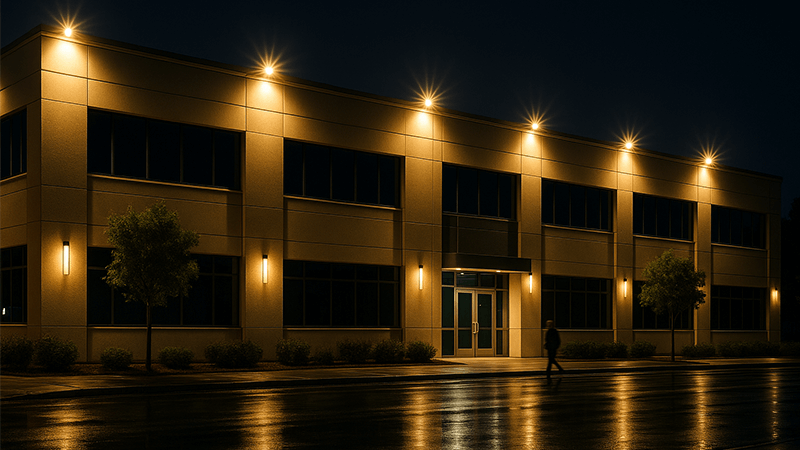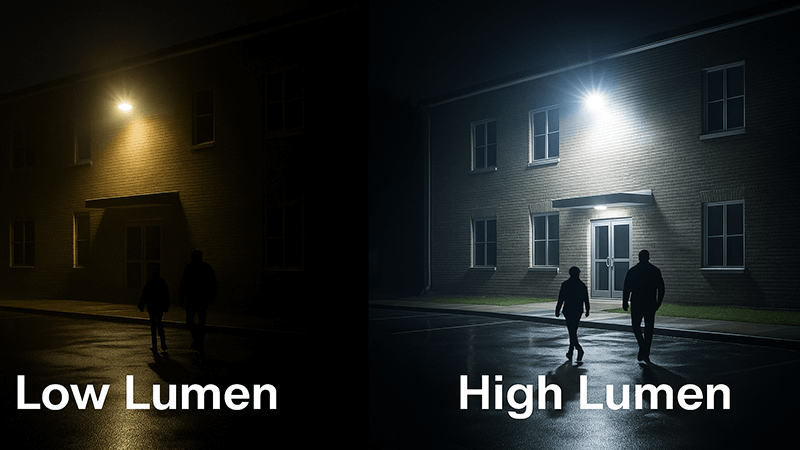Choosing the wrong floodlight wattage can be a costly mistake, leaving your space either too dim or blindingly bright. I’ll help you understand what really matters for perfect illumination.
The best wattage for an outdoor floodlight depends entirely on its purpose. For home security, 15-30W (1,500-3,000 lumens) is often sufficient. For larger commercial areas, you may need 50-150W (5,000-20,000 lumens). Always prioritize lumens, the true measure of brightness, over watts.

Selecting the right wattage seems straightforward, but there’s a critical detail many overlook that can make or break your lighting project. I’ve seen it happen many times over my years in the lighting business. Let’s dig deeper to ensure you get the perfect brightness for your needs, so you can make an informed decision and avoid common pitfalls.
How many watts should my flood light be?
Are you struggling to choose a specific wattage for your project? This uncertainty can be frustrating and delay your work. I will help you pinpoint the exact wattage range you need.
Your floodlight’s ideal wattage is tied to its application. Use 10-20W for small residential yards or entryways. For driveways or medium-sized commercial areas, 30-50W is a great choice. Large spaces like building facades may require 100W or more for adequate coverage.

The question of “how many watts” is one I hear almost every day. My answer always starts with another question: “What are you trying to light up?” The specific application is the most important factor. You wouldn’t use the same light for a small garden as you would for a large warehouse loading bay.
I remember a client, a purchasing manager from the UAE much like Shaz, who was set on ordering 100W floodlights for a hotel’s walkway. He thought higher wattage automatically meant better quality. I asked him about the space and showed him that a high-efficiency 30W floodlight would provide more than enough brightness while saving his company nearly 70% on energy costs. He was amazed. The key is to match the power to the purpose.
Here is a simple breakdown to guide your decision-making.
For Residential Security
For a typical home, you want to illuminate key areas like doors, driveways, and backyards without creating light pollution for your neighbors. In these cases, lower wattage is better. A 10W to 30W LED floodlight is perfect. This provides enough light to deter intruders and help you see clearly at night.
For Commercial Spaces
When we talk about commercial properties, like storefronts, small parking lots, or building perimeters, the needs change. You need more brightness to ensure safety and security for customers and employees. Here, I recommend a range of 30W to 70W. This provides excellent coverage and visibility for medium-sized areas.
For Large-Scale Projects
For big projects such as sports fields, large industrial yards, or architectural lighting for tall buildings, you need serious power. Wattages can range from 100W all the way up to 500W or more. The goal here is broad, powerful illumination over a vast area.
Here’s a table to simplify it:
| Application Area |
Recommended Wattage |
Recommended Lumens |
| Home Entryway/Patio |
10W – 20W |
1,000 – 2,000 lm |
| Driveway/Backyard |
20W – 40W |
2,000 – 4,500 lm |
| Small Parking Lot |
40W – 80W |
4,500 – 9,000 lm |
| Building Facade |
80W – 150W |
9,000 – 20,000 lm |
| Sports Field/Large Lot |
150W – 500W+ |
20,000 – 60,000 lm+ |
Always remember, these are guidelines. Factors like mounting height and beam angle also play a huge role.
What is the best wattage for outdoor lighting?
Outdoor lighting is more than just floodlights. Feeling confused about what wattage to use for wall packs or pathway lights? This uncertainty can lead to a mismatched and inefficient lighting scheme.
There is no single “best” wattage for all outdoor lighting. For pathways, 5-10W is plenty. For general area security, 30-70W wall packs work well. For street lights, you’ll need 100-300W. Always match the fixture’s wattage and brightness to its specific job.

When clients ask me for the “best” wattage, I always explain that it’s like asking a chef for the “best” ingredient. The best ingredient depends entirely on the dish you are making. The same logic applies to outdoor lighting. Every fixture has a purpose, and its wattage should reflect that. It’s about creating a complete, functional, and efficient lighting system, not just finding one powerful light.
Let’s break down the different types of outdoor lighting and the typical wattages I recommend based on my experience manufacturing these products.
Pathway and Garden Lights
These lights are for guidance and accenting landscape features. Their purpose is subtle illumination, not intense brightness. You don’t want your garden path to look like an airport runway.
- Purpose: Safety on walkways, highlighting plants.
- Recommended Wattage: 5W – 15W. This is low because the lights are often mounted close to the ground and you only need small pools of light.
Wall Packs and Security Lights
These are the workhorses of commercial building exteriors. They light up perimeters, loading docks, and entryways to ensure safety and security.
- Purpose: General security and area illumination.
- Recommended Wattage: 30W – 80W. This range provides a strong, wide beam of light to cover significant areas without being overpowering.
Parking Lot and Street Lights
For large, open areas like parking lots or public roads, you need powerful lights mounted on high poles. The goal is uniform, bright light across a vast space.
- Purpose: Wide-area illumination for vehicle and pedestrian safety.
- Recommended Wattage: 100W – 300W, and sometimes even higher for major highways or large industrial lots. The high mounting height requires more power to push the light down to the ground effectively.
Here’s a table summarizing these different fixture types:
| Fixture Type |
Typical Application |
Common Wattage Range |
| Bollard/Path Light |
Walkways, Gardens |
5W – 15W |
| Wall Pack |
Building Perimeters |
30W – 80W |
| Canopy Light |
Gas Stations, Overhangs |
40W – 100W |
| Pole/Street Light |
Parking Lots, Roads |
100W – 300W+ |
By understanding these categories, you can build a layered lighting plan where every light has the right wattage for its specific task. This approach not only looks better but is also far more energy-efficient.
How bright should an outdoor flood light be?
Worrying that your new floodlights will be too dim or, worse, create blinding glare for everyone nearby? This is a common concern. Let’s talk about brightness in the right terms.
Focus on lumens, not watts. A 30W floodlight can be brighter than an old 50W one. For general home security, aim for 2,000-4,000 lumens. For commercial lots, 10,000-20,000 lumens is a good starting point. Check the lumens to ensure you get the brightness you need.

For years, we’ve been trained to think about brightness in terms of watts. When I started in this industry, a 100W incandescent bulb was a standard measure. But with LED technology, everything has changed. Wattage is now a measure of energy consumption, not brightness. The real measure of brightness is lumens (lm).
This is the single most important concept I teach my clients. A higher lumen count means a brighter light, period. Two 30W floodlights from different manufacturers can have completely different lumen outputs. This is due to their luminous efficacy, which is measured in lumens per watt (lm/W). A high-quality fixture might offer 150 lm/W, while a cheaper one might only give you 90 lm/W.
Let’s look at an example:
- Floodlight A: 30W at 90 lm/W = 2,700 lumens
- Floodlight B: 30W at 150 lm/W = 4,500 lumens
Both lights consume the same amount of power, but Floodlight B is significantly brighter. This is why I always tell purchasing managers like Shaz to look at the lumen specification first. It tells you the true performance of the light.
Brightness Recommendations in Lumens
To make it easier, here are my general recommendations for brightness levels based on the job:
- Accent Lighting (small tree, statue): 500 – 1,000 lumens
- Pathway & Stair Lighting: 100 – 300 lumens (per fixture)
- Home Security (driveway, yard): 2,000 – 4,000 lumens
- Commercial Building Security: 5,000 – 10,000 lumens
- Parking Lot (small to medium): 10,000 – 25,000 lumens
Instead of asking “how many watts?”, start asking “how many lumens?”. This simple shift in thinking will ensure you always get the right amount of light and the best value for your energy spend.
What is the difference between 20W and 30W floodlight?
Does a 10-watt difference really matter that much? You might be tempted to just pick one, but this small choice can impact both your light coverage and your electricity bill.
The main difference is brightness and energy use. A 30W floodlight is typically 30-50% brighter than a 20W version, making it better for larger areas. The 20W is more energy-efficient and ideal for smaller spaces like patios or short driveways where less intense light is needed.

On the surface, the difference between a 20W and a 30W floodlight seems simple: one uses 10 more watts of power. But in practice, this 10-watt gap has a significant impact on performance, application, and long-term cost. As a manufacturer, I deal with these specifications daily, and I can tell you the choice between them is a common decision point for my clients.
Let’s break down the key differences to help you decide which one is right for your project.
Brightness and Coverage Area
The most noticeable difference is the light output. Assuming similar efficacy (lumens per watt), a 30W floodlight will produce significantly more lumens.
- A 20W Floodlight (at 130 lm/W): produces around 2,600 lumens. This is great for illuminating a space of about 10-15 feet (3-5 meters) from the fixture. Think of it as perfect for a residential doorway, a small patio, or a single-car driveway.
- A 30W Floodlight (at 130 lm/W): produces around 3,900 lumens. That extra brightness allows it to effectively cover a larger area, maybe 20-30 feet (6-9 meters) out. This makes it a better choice for a two-car driveway, a backyard, or the side of a small commercial building.
Energy Consumption and Cost
While a 10-watt difference doesn’t sound like much, it adds up over time, especially when you have multiple fixtures. Let’s calculate the difference for a single light running for 10 hours a day.
- 20W Fixture: 20W x 10 hours/day x 365 days = 73 kWh per year.
- 30W Fixture: 30W x 10 hours/day x 365 days = 109.5 kWh per year.
The 30W fixture uses 50% more energy. If you have 20 lights, that’s a considerable difference in your annual electricity bill. This is why choosing the right wattage is crucial. Don’t pay for light you don’t need.
Here is a comparison table:
| Feature |
20W LED Floodlight |
30W LED Floodlight |
| Typical Lumens |
2,000 – 2,800 lm |
3,000 – 4,500 lm |
| Best Application |
Patios, doorways, small yards |
Driveways, backyards, building sides |
| Coverage Area |
Small to medium |
Medium to large |
| Energy Use |
Lower |
50% Higher |
| When to Choose |
When you need focused, sufficient light |
When you need broader, brighter coverage |
Choosing between 20W and 30W comes down to a simple trade-off: do you need the extra brightness and coverage of the 30W, or is the energy efficiency and subtlety of the 20W a better fit for your space?
Conclusion
Choosing the right wattage means focusing on lumens for brightness and matching the fixture to the specific area. This ensures perfect illumination and saves energy.